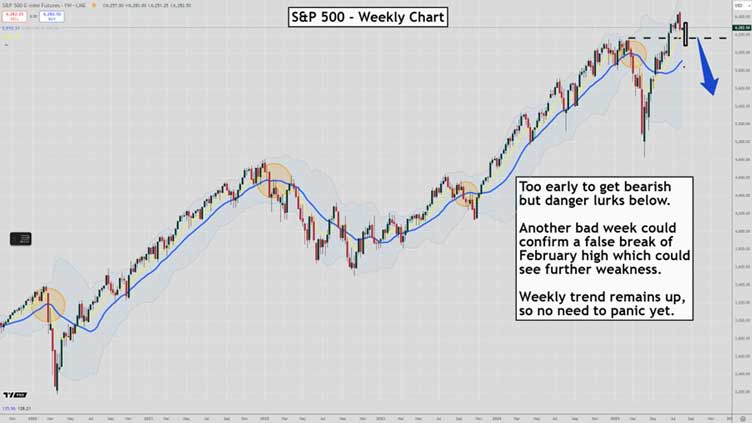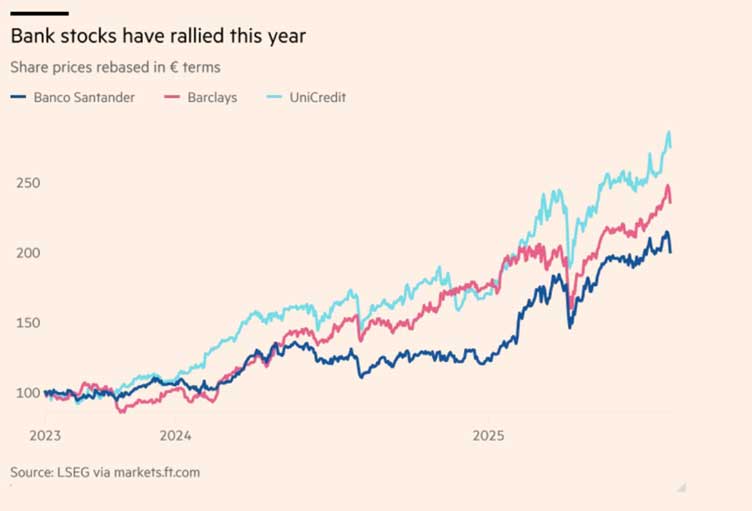Let’s see…
Everywhere you look you’re going to hear about Trump’s latest tariff bout. India is now getting a right hook across the jaw.
Then there’s those revised employment figures out of the USA not doing the outlook any favours.
Is there any good news?
As it happens, yes.
But odds on no one will point it out to you anywhere else than here.
What is that good news?
It might sound obscure at first, but stay with me.
European banks just hit their highest level since 2008. Check out the recent rally…
| |
| Source: Financial Times |
This is important.
Remember, it was only earlier in the year that we were reading about how US banks were releasing great results.
Here’s the thing…
Banks are the lynchpin of the economy because they control and create credit.
Rising rates have helped the euro banks immeasurably.
This is counterintuitive to the general perception, because everybody associates low rates as a “good” thing.
But not if you’re a bank. Zero rates make it very hard for them to make money.
They need a decent spread between their cost of funds and the loans they make.
This is why many market participants watch the ‘yield curve’.
A steep yield curve usually indicates good growth ahead.
Ken Fisher explains it further…
‘Like a dashboard indicator, the yield curve usually predicts bank lending trends. Banks use short-term deposits to fund long-term loans — pocketing the spread. Borrow at one rate, lend at a higher rate. Steep curves mean bigger profits, so banks lend eagerly, spurring growth.’
The fact that euro banks are hitting new highs says the market sees a bright 12 months ahead of them, and the euro economy.
Europe has largely fallen out of the market conversation these days. It doesn’t have much in the way of high tech and the demographics are dodgy.
It’s mostly in our minds as a holiday destination, for the lucky.
That said, there’s hundreds of millions of people in Europe. And it provides a big market for Chinese goods and US technology. A healthy Europe is a good thing for the global market.
Euro banks, according to the Financial Times, onlytrade on 10x their forward earnings. US banks are at 13.
That’s another way of seeing how crazy the valuation on CBA looks out here. It’s on 30x!
My job today is not to make the case for selling CBA and buying Lloyds in the UK, though their looks to be a strong logic to that idea.
We’re only interested in the euro banks because it suggests that, for all Trump’s antics and tariffs, the global economy is holding together, and so are the markets.
Of course, we could get a bout of selling in the short term. But I don’t see any evidence that we have to worry about a ‘systematic’ threat to the share market.
Speaking generally, we remain in a structural bull market.
The implication to this line of thinking is that any sell off in the market is a chance to acquire more shares in businesses you like long term.
And keep an eye on those euro bank shares. If we see the opposite…banks shares hitting new lows…we know there’s trouble on the horizon.
Best Wishes,

Callum Newman,
Editor, Small-Cap Systems and Australian Small-Cap Investigator
***
Murray’s Chart of the Day –
S&P 500 Weekly Chart

Source: Tradingview.com
The terrible unemployment figures released on Friday in the US finally sparked some selling pressure.
Is it time to run for the hills?
I think there is a good case to be made that we are probably in the early stages of a correction within the long-term bull market.
But the beauty of technical analysis is that it stops you from doing dumb things.
Instead of relying on gut feel you are forced to stick to a set of rules that must be confirmed before your view and trading approach changes.
As it stands on the weekly chart shown above it is too early to become bearish.
But the set up is there that if we see another week of serious selling pressure a false break of the February high could be confirmed which may spark a correction.
Look at the chart above again and you can see four orange circles that I have traced out.
They show you each time the S&P 500 has tipped over into a weekly downtrend since 2019.
You can see that in three out of four instances the confirmation of the weekly downtrend correctly predicted the coming weakness.
As it stands right now we are nowhere near seeing a weekly downtrend confirmed and one may not be confirmed for months to come.
So even if we do see a false break of the February high and a correction unfolds it will be within a weekly and monthly uptrend.
The correction could be shallow before the buying returns and the relentless rally continues.
Just as one swallow doesn’t make a Summer, one bad week doesn’t make a downtrend. So let’s remain open minded as we move forward, aware that a rough ride could be on the way but there’s no need to panic.
Regards,

Murray Dawes,
Editor, Retirement Trader



Comments